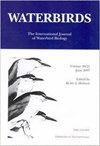Ranging Behaviour and Habitat Selection of Sedentary Western Marsh Harriers (Circus aeruginosus) in the Mediterranean Estuarine Landscape.
IF 0.6
4区 生物学
Q3 ORNITHOLOGY
引用次数: 0
Abstract
Abstract. The main reasons for the global biodiversity decline are the destruction and degradation of natural habitats caused by human activity by transforming them into agricultural lands. Although this transformation has been linked with decreased biodiversity, some bird species might have learned how to benefit from newly created habitats. We studied home ranges and habitat preferences for daytime activity and roosting of two sedentary Marsh Harriers (Circus aeruginosus) from the Evros Delta and the Mediterranean coast of the Iberian Peninsula using the results of satellite telemetry tracking. The size of the home range for the bird tagged in the Evros Delta was 158 km2 (dynamic Brownian Bridge Movement Model, 95 %), while for the Iberian bird, this was more than nine times greater (1488 km2). Monthly home ranges noticeably increased during winter in Evros Delta in both years.. The birds chose habitats such as non-irrigated arable land, watercourses, inland marshes, and dump sites for daytime activity. In contrast, they avoided habitats like rice fields and complex cultivation patterns. Water-related natural habitats like inland and salt marshes were intensively used as nocturnal roosts. Despite the general negative effect of human pressure, our results showed that the species seemed to tolerate and benefit from some types of humanized environments of estuarine landscapes.地中海河口景观中定居的西部沼泽鹞(Circus aeruginosus)的漫步行为和栖息地选择。
摘要全球生物多样性减少的主要原因是人类活动将自然栖息地改造成农田,导致自然栖息地遭到破坏和退化。尽管这种转变与生物多样性的减少有关,但一些鸟类可能已经学会了如何从新创造的栖息地中获益。我们利用卫星遥测跟踪的结果,研究了埃夫罗斯三角洲和伊比利亚半岛地中海沿岸两只定居的沼泽鹞(Circus aeruginosus)白天活动和栖息的家园范围和栖息地偏好。在埃夫罗斯三角洲被标记的沼泽鹞的活动范围为 158 平方公里(动态布朗桥运动模型,95%),而伊比利亚沼泽鹞的活动范围是其 9 倍多(1488 平方公里)。在埃夫罗斯三角洲的冬季,每月的家园范围在这两年都明显扩大。鸟类白天活动的栖息地包括非灌溉耕地、河道、内陆沼泽地和垃圾场。相反,它们则避开稻田和复杂的耕作模式等栖息地。内陆沼泽和盐沼等与水有关的自然栖息地被大量用作夜间栖息地。尽管人类的压力普遍产生了负面影响,但我们的研究结果表明,该物种似乎能够容忍河口景观的某些类型的人性化环境,并从中受益。
本文章由计算机程序翻译,如有差异,请以英文原文为准。
求助全文
约1分钟内获得全文
求助全文
来源期刊

Waterbirds
生物-鸟类学
CiteScore
1.30
自引率
0.00%
发文量
0
审稿时长
6-12 weeks
期刊介绍:
Waterbirds is an international scientific journal of the Waterbird Society. The journal is published four times a year (March, June, September and December) and specializes in the biology, abundance, ecology, management and conservation of all waterbird species living in marine, estuarine and freshwater habitats. Waterbirds welcomes submission of scientific articles and notes containing the results of original studies worldwide, unsolicited critical commentary and reviews of appropriate topics.
 求助内容:
求助内容: 应助结果提醒方式:
应助结果提醒方式:


